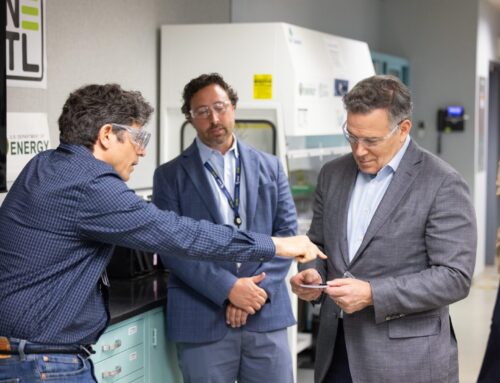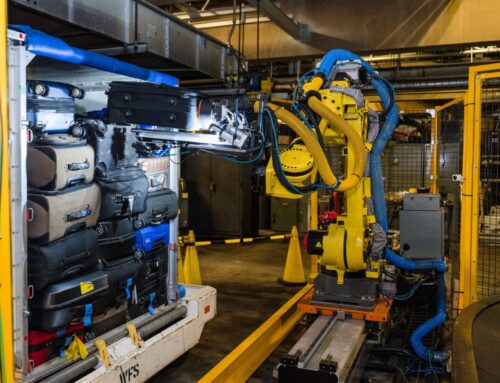Fully Operational Microgrid Paying Dividends for PIT
Power grid producing enough energy to power 11,000 homes
By Evan Dougherty
Published October 11, 2021
Read Time: 4 mins
It has been four months since Pittsburgh International Airport’s one-of-a-kind microgrid went online.
Following three years of design, development, construction and testing, PIT’s new power grid achieved full operational capability on July 14. Using both solar and natural gas, PIT became entirely self-sufficient for power generation, making it resistant to any widespread power outage on the traditional grid.
The power generated at PIT is the primary supply for the entire airport, including the terminals, airfield, Hyatt hotel and Sunoco. The airport remains connected to the traditional electrical grid as an option for emergency or backup power if needed. The microgrid generates power, in part, through onsite natural gas wells and solar panels spread across eight acres.
Since reaching full operation, the microgrid’s natural gas plant has generated a total of 37,805 megawatt hours—enough to power up to 11,291 homes per month. Of that total, PIT has used up to 87 percent of the supply, with the rest being exported to the traditional electrical grid.
Additionally, the solar field has generated approximately 1,300 megawatt hours of electricity, which represents 621 homes per month. The airport has used nearly 72 percent of the total solar output.
The microgrid “not only provides us our electricity needs daily, but it also allows us to remain active and powered in the event of a region-wide power outage,” said Project Manager John Bevilacqua. “So many groups coming together to build a system that can do something amazing like powering the small city that is our airport in any situation is an inspiration and a testament to what the people of Pittsburgh can do.”
In July, airport officials and federal, state and county leaders cut the ribbon in front of 9,360 solar panels glistening in the sun, part of a microgrid more than two years in the making.
The first-of-its kind power grid increases resilience and maximizes public safety, making PIT one of the most resilient airports in the world.
“Not even a pandemic could stop this innovation,” said Pittsburgh International Airport CEO Christina Cassotis. “PIT is now one of the most site-hardened public facilities in the world while at the same time becoming more sustainable. That’s a tribute to the innovative culture of our team, and we hope this project can be a model across the industry.”
Airports across the country have been exploring ways to increase power resilience and reliability after several high-profile power outages resulted in thousands of cancelled flights and passenger disruptions. As PIT prepares to break ground on building the smartest airport in the world through its new terminal project, creating smart power infrastructure is a key step that can serve as a blueprint for others.
“Our region has innovation in its DNA, and the construction of this microgrid reflects the work that has been done at the airport to maximize public safety and sustainability,” said Allegheny County Executive Rich Fitzgerald. “When you’re coming in for a landing and you see this huge solar array, it sends a signal that the Pittsburgh region is moving forward when it comes to sustainability, dealing with climate change and dealing with resiliency.”

Airport and elected officials marked the completion of PIT’s microgrid with a ribbon cutting ceremony on July 14 in front of more than 9,000 solar panels. (Photo by Beth Hollerich)
Local officials, including U.S. Rep. Conor Lamb, state Sen. Devlin Robinson, state Rep. Valerie Gaydos and county Councilman Sam DeMarco, all cited the project as another example of the industry-leading innovation at PIT that has caught the attention of leaders in Washington and Harrisburg.
“We talk a lot about the natural resources we have in Western Pennsylvania, but our best resource is our people,” said Lamb, whose district covers the airport. “And I know that you guys built something here and made something happen here that your peer crews at airports across the country probably couldn’t pull off. I always think that’s our best advantage.”
The Allegheny County Airport Authority Board of Directors in 2019 awarded Peoples Natural Gas a 20-year contract to build, maintain and operate the microgrid at no cost to the airport. In addition to boosting power resiliency and redundancy, the microgrid will achieve savings on electricity costs for the airport and tenants.
In exchange for building the microgrid, the airport provided the land and agreed to buy its electricity over the next 20 years.
Crews started construction in July 2020 and completed the project on schedule even as the pandemic stalled the aviation industry.
“Essential Utilities and Peoples Gas are proud to be an integral part of the airport microgrid project,” said Christopher Franklin, chairman and chief executive officer, Essential Utilities. “We’re demonstrating how new, alternative energies like solar can be integrated with traditional power sources like natural gas. This energy solution provides the airport with a more resilient power supply, as well as reducing its emissions.”
What is a microgrid?
A microgrid is an independent electricity source that can operate autonomously while maintaining a connection to the traditional grid. It is powered by natural gas drilled on-site by CNX Resources, in addition to gas from the interstate pipeline system and solar generation.
The microgrid consists of five natural gas-fueled generators and nearly 10,000 solar panels, capable of producing more than 20 megawatts of electricity.
IMG Energy Solutions partnered with Peoples and the Airport Authority as owner and operator of the solar array and operator of the natural gas generators.
“This first-of-its kind project not only brings energy resiliency to the airport but leads this region’s transition to clean energy while creating new jobs and providing decades of clean, cost-effective energy to the airport and its tenants,” Mike Brady, CEO of IMG Energy Solutions.
Executive Editor Bob Kerlik also contributed to this story.






